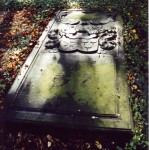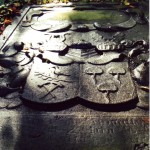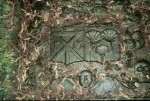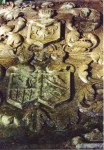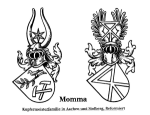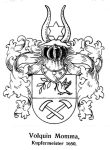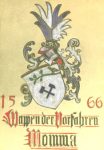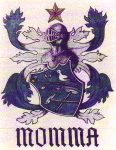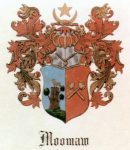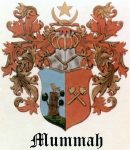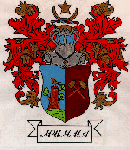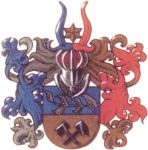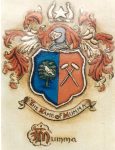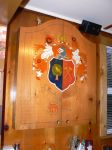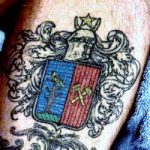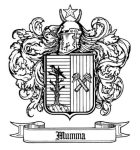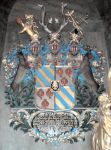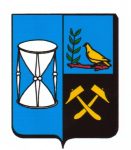Momma
Coat of Arms
The following bits and pieces of general information about Coats of Arms have been gathered from a variety of sources. If you have further interest, I suggest you do an Internet search and you will discover many interesting web sites devoted to this subject. The following is a very brief background into the subject of coats of arms in general and specifically the Momma Coat of Arms.
COATS OF ARMS
Coats of Arms, called "Wappen" in German, have been used in most parts of the world for centuries. In the British Kingdom, the rules of heraldry are very specific and Coats of Arms are still highly regulated. You are simply not allowed to use a Coat of Arms that was issued to a specific person. Technically, one must prove lineage to the individual first awarded the Coat of Arms to be entitled to them. You can even be fined, similar to a copyright infringement.
In many countries in the middle ages, Germany for one, every free man was allowed to bear a Coat of Arms, hence the proliferation of "working class" symbols. Almost all cities did and still do create Coats of Arms. Often they were awarded to individuals and became much like inherited property (although they would still need to apply to the Heraldic authority to be granted the Arms). Special symbols (marks of cadency) could be added to differentiate between 1st, 2nd, 3rd, etc. grown children. However, in the USA and present day Germany, for instance, anyone may assume a Coat of Arms, as there no longer is any Heraldic authority to whom you can apply.
IS THERE A COAT OF ARMS FOR THE MOMMA OR MUMMA FAMILIES?
The Mommas of Aachen and Stolberg, Germany were among the influential families who produced copper and brass. They were called "Kupfermeisters". Various Coats of Arms were used as "seals" by the individual "Kupfermeisters" to identify their products and other items. The "Kupfermeisters" even used a "family" Coat of Arms on the lids of their burial vaults found in the Finkenberg Reformed Church cemetery in Stolberg, Germany. The carvings were a way to identify from which family a person descended, especially in the case of a woman. For the tombstone on the burial vault of Leonard Konrad Momma b:1658, the MOMMA coat of arms is displayed on the left and his wife's PELTER coat of arms is on the right. A picture of this stone is shone below. Some of the surnames of these "Kupfermeister" families were named Dollart, Lynen, Koenen, Mewis, Peltzer, Prym & Schardinel, all of whom had, and used family Coat of Arms.Thus, It is clear that these surnames used "family" Coat of Arms! If you search the Mumma database, most of these surnames are found due to intermarriages between the Kupfermeister families. Some research into the Momma Coat of Arms was conducted by Lothar Müller-Westphal, a heraldic artist from Düren. From his studies he felt that there was an even earlier Momma Coat of Arms which was of a simple line design that could have been easily used as a man's "mark". This design is shown next to the more classic design in pictures at the bottom of the article. In addition, Stefan Momma sent me a Coat of Arms which he has showing the date of 1566 inscribed with the words, "Coat of Arms of the Momma family". So, the Momma "family" Coat of Arms has been used for a long time.
My conclusion is that all descendants of the Momma family may use a MOMMA Coat of Arms without feelings of guilt. Your British friends will just be envious! You are simply carrying on a proud and distinguished tradition that our "Kupfermeister" ancestors established over 440 years ago. The fact that the Mumma (and other surname spellings) descend from the Momma families of Germany is well supported and confirmed by DNA testing.
THE AMORIAL GÉNÉRIAL
Johannes Baptista Rietstap (12 May 1828 - 24 December 1891) was a Dutch heraldist and genealogist. He is most well-known for his publication of the Armorial Général. This monumental work contains the blazons (a written description of a Coat of Arms) of more than 130,000 European families. It is still one of the most complete works of its kind. The MOMMA blazon is described and a Coat of Arms displayed in this book. It is listed as having a Dutch origin for Volquin Momma whose family migrated from Stolberg Germany to Holland.
HERALDRY
The word "Heraldry" is derived from the German "heer" -- a host, an army -- and "held" -- a champion. The term "blazon", by which the science of heraldry is denoted in French, English, Italian, and German, is probably derived from the German word "blazen" -- to blow the horn. Source: Burke, Bernard, The General Armory of England, Scotland, Ireland, and Wales (Heritage Books, Inc., 1996).
FAMILY CRESTS
When people say a "Family Crest", they are usually referring to a "Coat of Arms", which is recorded (as words, not drawn) in a book of heraldry (i.e.: Burgerliches Wappenbuch) by a scribe in such a way that it does not matter who draws the Coat of Arms from the scribes description, it will always look as it should. This clever system was a language unto itself (actually, a "language within a language"), with much of the information simply implied. Craftsmen & Tradesmen (Smiths, Wrights, etc.) often included their tools of trade in their Coat of Arms. Usually only the Shield and sometimes a Crest are deScribed - it's very rare for the Mantling to be deScribed & then only when it deviates from the primary Metal & Color Tinctures. Rules of Heraldry were not always strictly adhered to and the one that was broken the most is the "law" that dictates "Metal must not be borne upon Metal, nor Color upon Color" -- which, simply put, means that the lighter colored metals, silver & gold, can't be put upon each other but can be put upon any of the colors; all of which are dark & contrast only with the Metals. Obviously, there are ways around this, but even then it must have been "deScribed" by the (who else?) Heraldic Scribe.
MAIN ELEMENTS OF A COAT OF ARMS
What probably surprises most people is the fact a "Coat of Arms" is simply a written description of the elements that it should contain. It is left up to a heraldic artist (or yourself) to interpret the description and create a pleasing graphic design. This description is called a "Blazon". Therefore there is not a single design of the Momma Coat of Arms or for any other family, just a description of the elements it should contain. This why all Momma Coats of Arms should look very similar.
- Motto - In some cases, Coat of Arms will have some "motto" inscribed at the top. I am unaware that the Momma family ever had a motto associated with the Coat of Arms.
- Crest - The topmost device. It's attached to the top of the Helmet.
- Torse - A thin wreath of twisted cloth (upon which the Crest is assumed to rest) used to secure the Crest & Mantling to the Helmet. It is seldom specifically described - its 6 alternating twists implicitly take the colors of the Mantling. The Torse is commonly believed to have been adapted from the headdress of the Arab tribesmen during the time of the Crusades. The Torse is not an official part of the Arms.
- Visor - A part of the Helmet used to help determine rank - closed (or none) = Esquire/Citizen/Commoner. Helmet Rankings - 1. Sovereign - Affronty (facing viewer), Gold, at least 6 gold grilles (bars) 2. Nobles - Affronty or Affronty/Profile, 5 silver grilles 3. Knights - Affronty or Affronty/Profile, open visor instead of grilles 4. Esquires & Private Citizens - Profile (facing viewers left) or Profile/affronty , closed visor or no visor & no grilles
- Shield - The main part that holds all of the Ordinaries, Charges & other "decorations". Charge Anything placed upon the Shield.
THE BLAZON OF THE MOMMA COAT OF ARMS
The following blazon is recorded in Rietstap's Armorial Général for the Momma surname.
Momma - Amsterdam.Parti: au1 d'azur à un ironc d'arbre au nat., terrassé de sin., et un canari d'or perché sur une branche; au 2 de gu. à deux marteaux d'or. passés en saut. C.: une étoile (5) d'or entre deux cornes de buffle du méme. L. d'or et de gu.
One translation of the blazon is:
Divided in half vertically 1) blue, a tree trunk natural on green ground, a gold canary perched on one of the branches. 2) red, two gold hammers crossing". Above the shield and helmet is the Crest which is described as: A gold star between two buffalo horns.
You should find all of these elements in a Momma Coat of Arms, no matter who creates it.
So, What do these Elements Mean?
The Crest
- Buffalo Horns - The bearing of buffalo (Wisen in Europe) horns denote strength and fortitude.
- Mullet (Star) - The mullet indicates the bearer has some divine quality bestowed from above, whereby he shines in virtue and learning. Guillim says, "The stars may signify unto us a hopeful success and happy event, in the turbulent time of tempestuous flaws and turmoil of this present life."
The Visor/Helmet
- The visor is generally shown closed, but I have seen the helmet facing left and face on. I have not been able to draw any conclusion from this as to rank. The Momma family at this time period were wealthy and enterprising and I expect would have been considered to be minor nobility. I have seen several different interpretations of the elements. You can decide what you like.
The Shield
- Division - I have generally seen the shield divided vertically, as the description indicates, for Coats of Arms created by American artists, but the Coat of Arms is always divided horizontally (or with no obvious division) for early German styles. The Coat of Arms carved on Barbara Momma's tombstone in 1747 is divided horizontally. Likewise, Volquin Momma's 1650 Coat of Arms shows the shield divided horizontally. I personally favor the horizontal division design as being more correct. Perhaps an error was made in Rietstap's original recording of the blazon or its later translation. It is up to you to decide which way you want to depict a Momma (or your surname) Coat of Arms.
- Canary - Birds are often used in heraldic art, especially what we may call its accessory details, of which much was made in early days. Many and quaint as these are, they may all be traced back to very ancient tribal, totem, or religious symbols. Migration suggested the passage of the soul. The ease with which man's spirit left this body resembled nothing so much as flight. I have also seen this listed as a dove.
- Hammers - Since the Mommas were copper and brass producers, hammers were used extensively in their trade of producing copper and brass sheets. Hammers are an classic emblem of the smith's trade. The double-headed hammer was the emblem of mythical god, Thor."
Colors
Only four colors were typically used in Heraldic design, namely red, blue, green, black and two metals, gold and silver. This is true of the description of the Momma Coat of Arms, however one notices a fair amount of artistic license in the modern designs that have been created.
One of the most interesting descriptions of the elements of the Momma Coat of Arms was sent to me by Hans Momma of Eschweiler, Germany. It was a part of his history of the Momma family and its Wappen (Wappen in German means Coat of Arms). My crude translation is:
"On the Momma Coat of Arms, one finds Noah's dove on a branch as a sign of the rescue from the terrible exodus which can be compared with the (biblical) Flood and the dove came to him in the evening time with an olive leaf it had plucked (1st Moses VIII, 11). In addition to the star of Bethlehem, one sees two crossed hammers of a skilled craftsman."
I rather like this religious description of the elements.
The Coat of Arms shown below are ones I have collected from a variety of sources. If you would like to contribute one which you might have, I will be happy to add it to the collection.
The first images are photographs of several very old Momma tombstones located in the Finkenberg church cemetery in Stolberg, Germany. In this cemetery, the "coat of arms" of the surname of the husband and wife were carved, side by side into the lid of the tombstones. These old German examples always show the coat of arms divided
horizontally while more modern artistic renditions using the Rietstap blazon are divided vertically.
[Click on any image to enlarge it]
|
